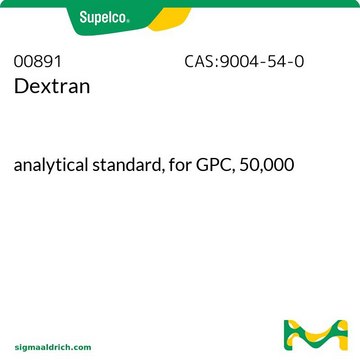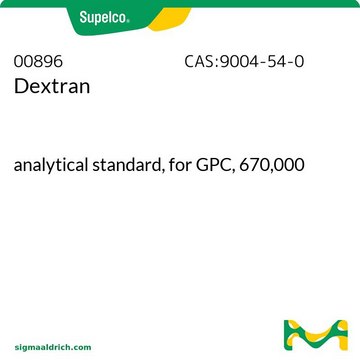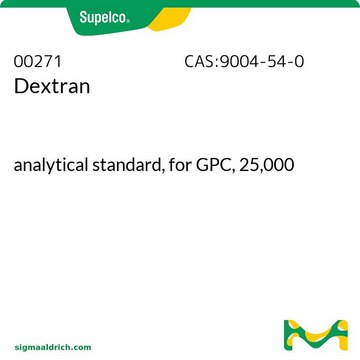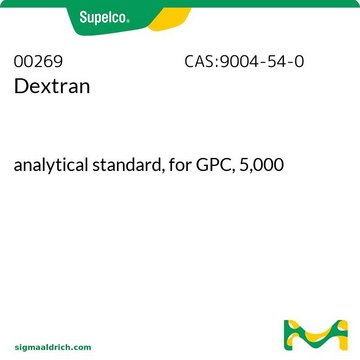All Photos(1)
About This Item
Linear Formula:
[C6H10O5]n
CAS Number:
EC Number:
MDL number:
UNSPSC Code:
12352201
NACRES:
NA.24
Recommended Products
grade
analytical standard
for GPC
Quality Level
form
powder or crystals
mol wt
Mn ~164200
Mp ~196,300
Mw ~273,000
analyte chemical class(es)
oligosaccharides
technique(s)
gel permeation chromatography (GPC): suitable
Mw/Mn
~1.66
application(s)
food and beverages
InChI
1S/C18H32O16/c19-1-5(21)9(23)10(24)6(22)3-31-17-16(30)14(28)12(26)8(34-17)4-32-18-15(29)13(27)11(25)7(2-20)33-18/h1,5-18,20-30H,2-4H2
InChI key
FZWBNHMXJMCXLU-UHFFFAOYSA-N
Looking for similar products? Visit Product Comparison Guide
General description
Dextran (mol. wt. 270,000) belongs to the family of neutral polysaccharides, which are recognized as contaminants in sugar processing and other food production industries. These are composed of chains of D-glucose units connected by alpha-(1-6) linkages of varying lengths. They are found as bacterial extracellular polysaccharides and reportedly synthesized from sucrose by beneficial lactic acid bacteria, such as Leuconostoc mesenteroides and Lactobacillus brevis. They are incorporated in bakery products to improve the crumb texture, softness, and loaf volume, as stabilizers and additives in confectionery, flavor extract, icing compositions, beverages including soft drinks, milk, etc.
Application
The analytical standards can also be used as follows:
- High-performance size exclusion chromatography (HPSEC) based determination of the molecular weight of a dextran synthesized by Leuconostoc citreum B-2, isolated from a fermentation product of pineapple
- Determination of molecular weight of polysaccharides obtained from four Auricularia species by high-performance liquid chromatography using a water-soluble gel column
- Identification of molecular weight of a water-soluble polysaccharide isolated by anion exchange chromatography from the dried leaves of C. paliurus by gel permeation chromatography (GPC)
- Gel permeation chromatography (GPC) based molecular weight measurement of a dextran produced by two strains of Leuconostoc mesenteroides
- Estimation of molecular weight of a water-soluble polysaccharide obtained from thinned-young apple by high-performance size exclusion chromatography (HPSEC)
Packaging
Bottomless glass bottle. Contents are inside inserted fused cone.
Storage Class Code
11 - Combustible Solids
WGK
WGK 2
Personal Protective Equipment
dust mask type N95 (US), Eyeshields, Gloves
Choose from one of the most recent versions:
Already Own This Product?
Find documentation for the products that you have recently purchased in the Document Library.
Customers Also Viewed
Functional polymers based on dextran
Polysaccharide-based Fibers and Composites: Chemical and Engineering Fundamentals and Industrial Applications, 199-291 (2006)
Dmitri Simberg et al.
Biomaterials, 30(23-24), 3926-3933 (2009-04-28)
In order to understand the role of plasma proteins in the rapid liver clearance of dextran-coated superparamagnetic iron oxide (SPIO) in vivo, we analyzed the full repertoire of SPIO-binding blood proteins using novel two-dimensional differential mass spectrometry approach. The identified
Ana Luisa Miranda-Vilela et al.
Journal of biomedical nanotechnology, 9(7), 1261-1271 (2013-08-06)
This work aimed to test a dextran-functionalized magnetic fluid (DexMF) sample in mediating magnetohyperthermia to treat an advanced clinical Ehrlich-solid-tumor, to verify the effects of oral antioxidant administration of pequi-oil on this treatment and to investigate the potential of these
Farwa Sarwat et al.
Pakistan journal of pharmaceutical sciences, 26(4), 793-797 (2013-07-03)
Leuconostoc are known to produce dextran, which have great commercial importance in chemical, medical and food industry. The present study is an attempt to select the best medium for the isolation of indigenous dextran producing Leuconostoc, measuring their enzyme activities
Wai-Leung Langston Suen et al.
Investigative ophthalmology & visual science, 54(6), 4358-4365 (2013-06-01)
This study aims to determine the in vivo effectiveness of low-frequency ultrasound in mediating the transport of macromolecules to the posterior segment of the eye via transscleral route. It investigates if damage is caused by ultrasound at the tested operation
Our team of scientists has experience in all areas of research including Life Science, Material Science, Chemical Synthesis, Chromatography, Analytical and many others.
Contact Technical Service










